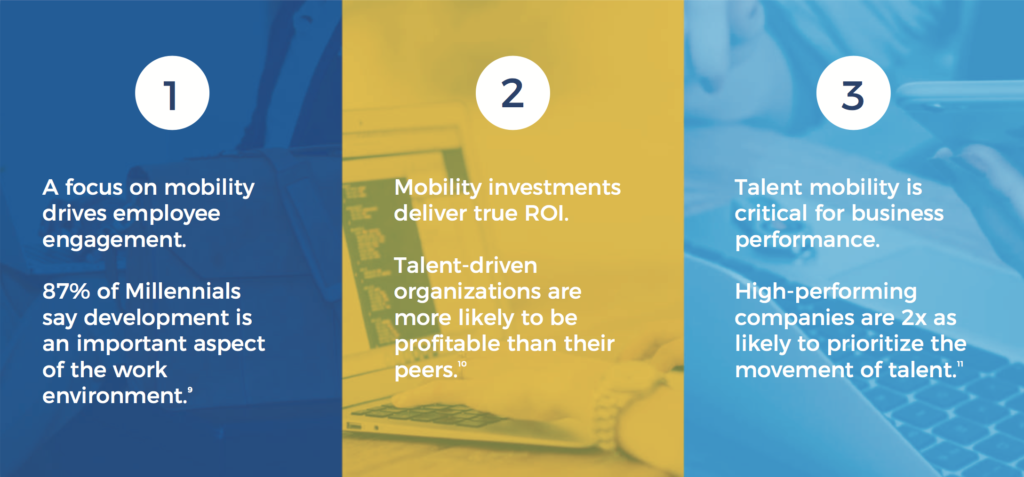Talent Mobility as a Key Business Practice
Talent mobility. It’s an evolving talent practice that delivers incredible value for the workforce and the business, and it gives the organization a powerful competitive edge. At the same time, many employers still aren’t sure how to define this practice and what might be involved, so we’re going to break that down for you today by exploring what it is, how the research proves out the value, and how technology plays a role in making it all come together.
What is Talent Mobility?
The concept of talent mobility is relatively new, but it’s made up of familiar terms. Talent mobility is a more holistic approach to managing talent than just relying on an executive-driven succession plan or an ad hoc method for promoting employees to higher levels of responsibility. In addition, talent mobility considers the aspirations and interests of the individual employee as well, creating engagement opportunities by meeting the needs of individual workers.
By being more inclusive of these options when considering the bigger picture, employers can not only find more opportunities to grow and develop their workforce–the employees respond with greater productivity and performance.
Research Proves the Value of Mobility
Did you know that external hires often have lower performance scores and cost more money than internally hired candidates? Were you aware that nine out of ten of your workers are open to considering other job opportunities? These are just two of the factors that explain why talent mobility is so incredibly important to the business, but it doesn’t stop there.
For instance, a recent study by the University of Phoenix pointed out that a third of employees are asking for development at work, but they aren’t confident in the firm’s development program to adequately prepare them for the challenges ahead. Additionally, that same study showed that one in three hiring managers plan to create cross-functional learning opportunities in order to improve innovation.
Each of these pieces of research builds a business case for creating a streamlined program designed to grow and develop workers into more valuable assets for the organization. In the graphic below we outline three key areas where talent mobility can have a greater organizational impact.
Technology’s Role in the Process
Hopefully, by now you understand the value of talent mobility for workers and the business, but how does a company get started? In recent years technology has played a key factor in driving talent mobility performance because it allows employers to get a more granular look at the skills and competencies of available talent. Imagine trying to manually track the skills of thousands of employees. For starters, skills are dynamic, not static. Also, there’s no way to know if all skills have been captured, because many times they can lie beneath the surface unless they are required in an existing role. For these reasons, software is the best way to track and manage talent pools based on competencies.
In addition, technology can help to facilitate conversations between workers and their leaders, because it can offer up customized career pathing. If Jamie wants to move into a more senior role, the technology can illuminate any missing skills that would be necessary for the promotion. Or if Lesley has an interest in moving laterally into a related role, the platform can show what steps are necessary to make the move. If businesses are relying solely on managers to have these conversations and open up these opportunities, they are missing out, because our research with hundreds of HR executives shows that managers just aren’t that great at having career development conversations.
If this topic is of interest and you’d like to bring talent mobility to your own organization, I’d love for you to reach out to discuss your specific challenges and approach. I can offer several case studies to help you understand how other companies are putting this practice into action, creating value for the workforce and the rest of the business stakeholders. Together we can create a more engaging workplace, retaining your best performers and growing them to higher levels of success.

Ben Eubanks is the Chief Research Officer at Lighthouse Research & Advisory. He is an author, speaker, and researcher with a passion for telling stories and making complex topics easy to understand.
His latest book Talent Scarcity answers the question every business leader has asked in recent years: “Where are all the people, and how do we get them back to work?” It shares practical and strategic recruiting and retention ideas and case studies for every employer.
His first book, Artificial Intelligence for HR, is the world’s most-cited resource on AI applications for hiring, development, and employee experience.
Ben has more than 10 years of experience both as an HR/recruiting executive as well as a researcher on workplace topics. His work is practical, relevant, and valued by practitioners from F100 firms to SMB organizations across the globe.
He has spoken to tens of thousands of HR professionals across the globe and enjoys sharing about technology, talent practices, and more. His speaking credits include the SHRM Annual Conference, Seminarium International, PeopleMatters Dubai and India, and over 100 other notable events.

